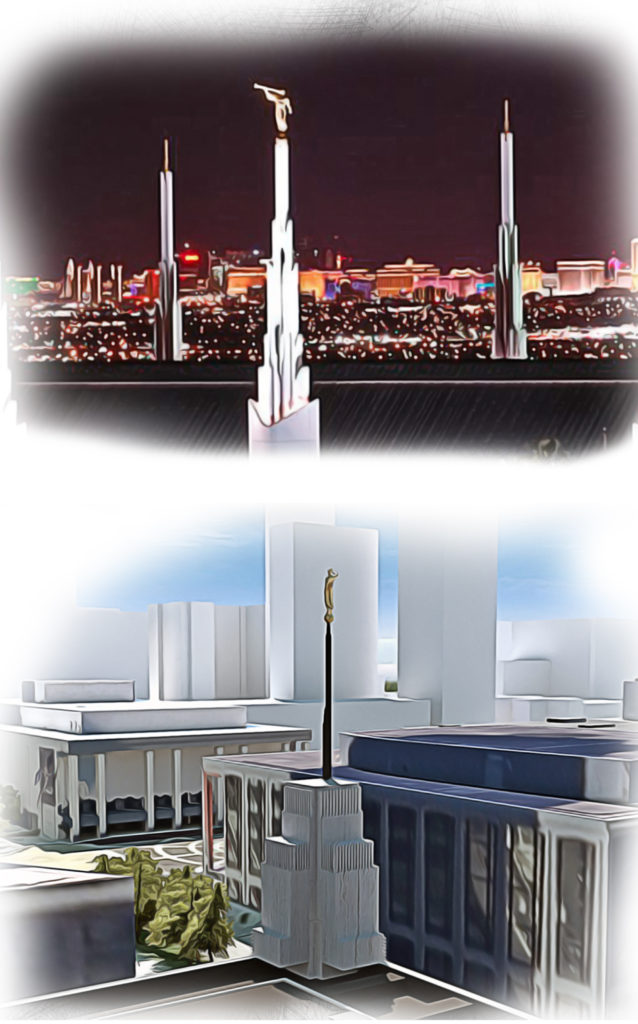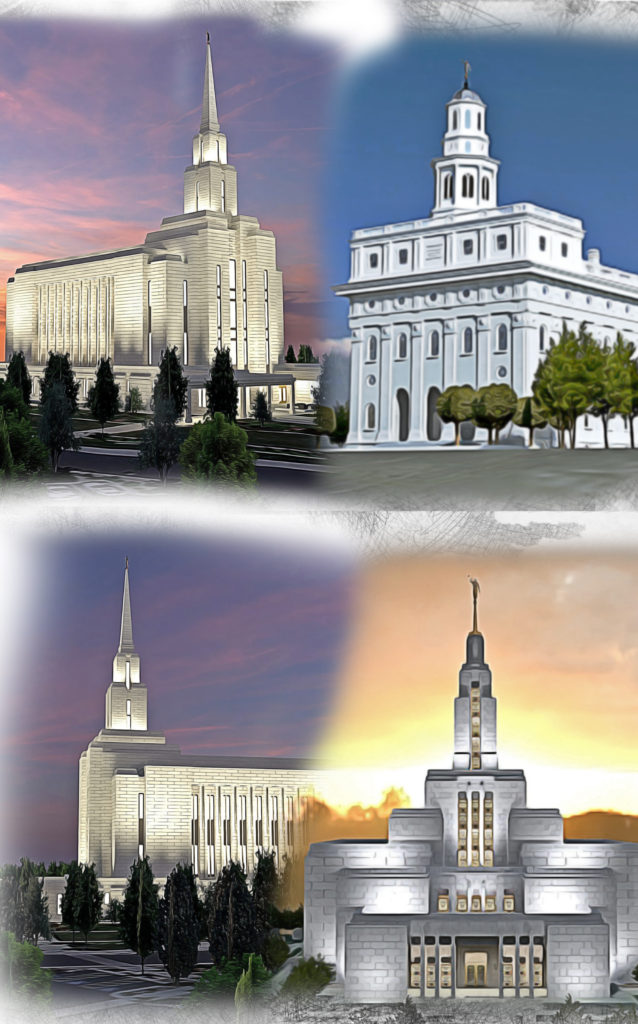Coincidental Angel Placements
Sometimes, the placement of a Moroni can lead to some interesting coincidences. Though it is possible that some of these are on purpose by the architect or planners, I have yet to find any proof that the placement was intentional. Here are a couple of interesting placements, coincidence or otherwise.
Turned His Back on the World
The Las Vegas Nevada Temple sits at the base of a lone mountain to the North East of downtown Las Vegas. The Angel on the temple is placed on the center spire of the long east side of the temple. The statue itself faces east; head tilted up towards the peak of the mountain. The overall effect of the placement is that the statue has his back turned to towards the Las Vegas Strip, home of many of the largest Casinos in the United States. It is most likely that the placement of this statue is coincidental, in that it was more common back then to have a statue placed facing directly east, even if the placement looked a little out of sorts for the temple (though in the case of Las Vegas, the placement fits well with the overall architecture of the building.) While this placement is most likely coincidental, in a sense, the Las Vegas Moroni has his back turned to a place famous for upholding loose morals popular in the world. Symbolically he has turned his back on the world, and has turned east to await the arrival of the Savior.
Playing to the Concert Hall
Starting in April of 1973, just one block west of Central Park, the Church began construction on a stake center and apartment building in what was then an area of Manhattan that was under redevelopment. The pair of buildings, designed by Church Architect Emil B. Fetzer would serve as a hub of Church activity for Manhattan for the next 30 years. Starting in 2001, that Stake Center would be renovated, and a temple placed inside the shell along with a new Chapel. The finished facilities were dedicated 13 June 2004. Four Months after the dedication, the decision was made to add an Angel Moroni statue to the spire that had been added during the remodel process. Placing the statue facing east would have placed it facing apartment buildings right next door and sharing an east wall with the temple. From an Aesthetic standpoint, it would have looked rather awkward.

The temple sits at the six-way intersection of West 65th street, Columbus Avenue, and Broadway. The intersection has a small pedestrian plaza in the middle where people can wait while the lights change. At the North and South ends of the intersection are more pedestrian plazas and greenspace. The Decision was made to place the statue facing out into this comparatively open space.
The end result is that the statue faces south west, rather than the somewhat more traditional east. This means that the trumpet points towards the Lincoln Center for the Performing Arts, one of the more famous Concert Halls in the world.
Old Home Faces New Home
Oquirrh Mountain Utah Temple was dedicated in 2009, and sits on the west side of Salt Lake valley. Imagine you were standing right at the South most edge of the temple, and faced east. Now imagine that you could instantly travel east on the same latitude line about 1,081.87 miles. When you came to a stop in the middle of a road you could then turn 90 degrees to the right, and there, just 136 feet away, would be the Nauvoo Temple. The Angel Moroni on the Oquirrh Temple faces east. Meanwhile, the Nauvoo statue was placed to face west, out across the Mississippi River. Across a distance of 1,080 miles, these two statues face each other nearly perfectly. More so than probably any other two Moroni statues in the world.
Saluting the Neighbor
Oquirrh Mountain Utah Temple sits on the east bench of Salt Lake Valley. As such, two other temples can clearly be seen from the front doors of the temple: The Jordan River Utah Temple, just 3.1 miles away, and the Draper Utah Temple, 8.61 miles away on the west side of the valley. As most Angel Moroni Statues, including the one at Oquirrh, have the trumpet turned about 45° to the right (clockwise) from the statues body, the trumpet at the Oquirrh temple just happens to point nearly perfectly at its neighbor across the valley, the Draper Utah temple.

Chapter 5 Navigation
